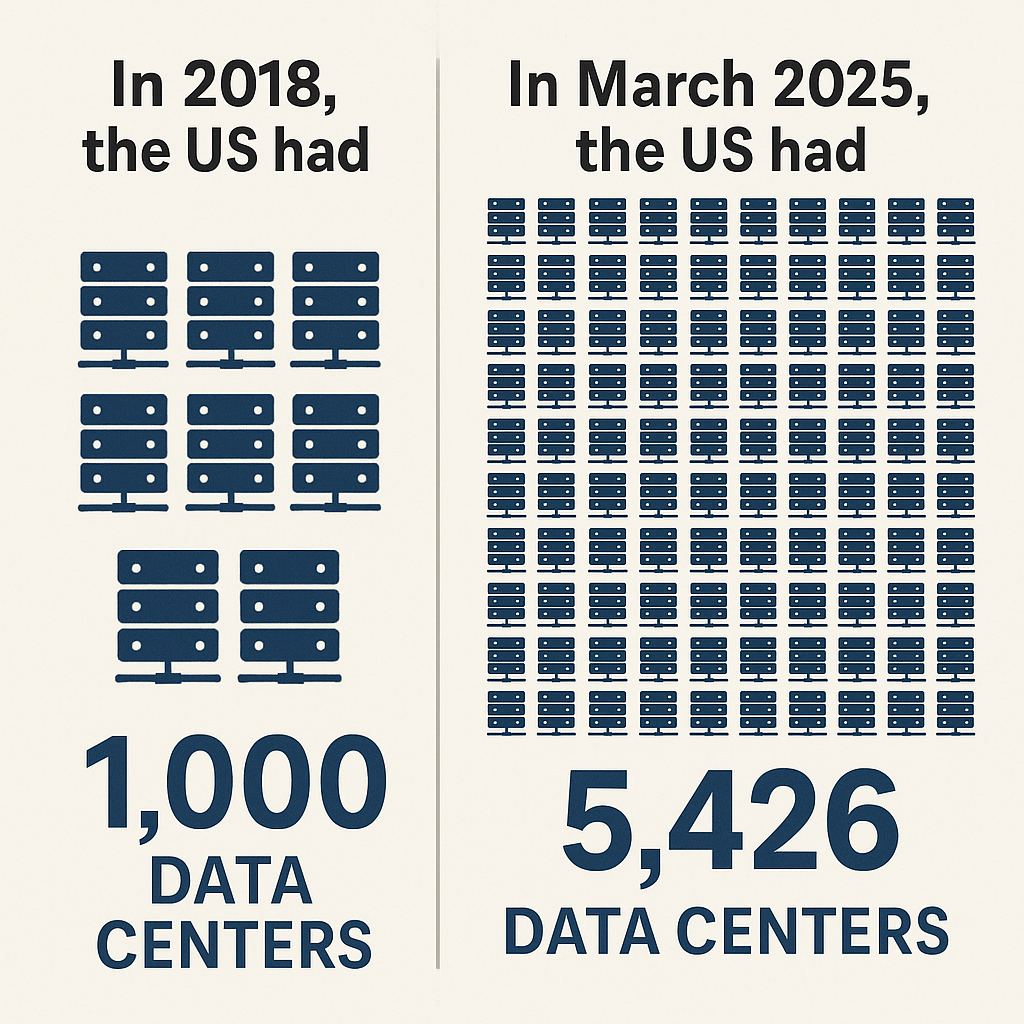They say the future belongs to the bold, but what if that future is built atop suffocated towns and poisoned skies? Across Northern Virginia, Silicon Valley, Memphis and beyond, data centers rise like new fortresses, steel-clad cathedrals of computation whose well air-conditioned, ice-cold interiors hum with tens of thousands of AI servers.
Inside, algorithms race toward artificial dominance; outside, families inhale nitrogen oxides and particulate matter invisible to the eye but devastating to the lungs. Children cough through asthma attacks. Parents scroll past zoning notices buried in legal jargon. And in Washington, the very agency sworn to protect public health is preparing to hand fossil-fueled power plants, the arteries of these digital colossi, a free pass to pollute more.
This is the modern paradox: the race to dominate AI is framed as progress, yet its infrastructure corrodes the air, water and health of the communities standing closest to it. The government knows it. The corporations know it. The public senses it. But we march forward, locked in collective cognitive dissonance where environmental collapse becomes an acceptable price for “winning” the AI game.
Data Centers: Energy Beasts in Disguise

The metaphor of the “cloud” hides an industrial reality: a sprawling network of energy-hungry facilities with a carbon footprint rivaling the world’s largest polluters. In 2018, the United States hosted roughly 1,000 data centers; by March 2025, that figure had exploded to 5,426, consuming 17 gigawatts, which is equal to 17 large power plants.
Projections suggest that by 2028, demand could double or triple, consuming up to 12% of all US electricity. More than half of this power comes from fossil fuels, releasing 105 million metric tons of CO₂e annually, with a carbon intensity 48% higher than the national average. If treated as a nation, the internet would rank as the world’s seventh-largest emitter, rivaling aviation.
Beyond electricity, data centers consume vast amounts of water for cooling, roughly 0.74 liters per gigabyte of internet use, placing them among the top ten water-intensive activities in the United States. Equipment lifespans, typically three to five years, exacerbate the footprint through rapid replacement cycles. Even popular online activities carry measurable consequences: streaming, cryptocurrency mining and AI-driven workloads together form a cascade of emissions, water withdrawals, and waste that make these “invisible” infrastructures a tangible environmental threat.
Related Article: AI's Voracious Appetite for Land, Water and Power Is Your Next Big Business Risk
2023–2025 Data Center Impact: Energy, Water & Health
| Topic | Latest figure | Timeframe | Why it matters | Source |
|---|---|---|---|---|
| US data center electricity use | 176 TWh (≈4.4% of US electricity) | 2023 | Confirms the US “floor” before the AI surge accelerates further. | 2024 United States Data Center Energy Usage Report |
| US data center growth outlook | Double to triple by 2028 | 2024–2028 | DOE/LBNL projects rapid load expansion; planning & siting urgency. | The Department of Energy's Energy.gov |
| Global data center electricity | ≈945 TWh projected | 2030 | IEA: global demand more than doubles; AI is the main driver. | IEA |
| US data center emissions intensity | ≈105 MtCO₂e; ~48% higher carbon intensity than US average | 2023 | Local grids still fossil-heavy “100% matched” ≠ local clean power. | Environmental and Energy Study Institute |
| Public-health costs from AI/data centers (US) | Up to >$20B/year | 2030 | Lifecycle pollutants (PM₂.₅, NOx, SO₂) comparable to CA on-road vehicles; harms concentrated in vulnerable communities. | California Institute of Technology |
| Northern Virginia/DC backup-gen externalities | $190–$260M/year | Current | Regional health damages from diesel backup cycles & testing. | California Institute of Technology |
| Water footprint of AI (training) | ~700,000 liters for one GPT-3 training run | Study published 2023 | Illustrates hidden freshwater cost of frontier models. | Association for Computing Machinery |
| Global AI-linked water withdrawals | 4.2–6.6 billion m³/year | 2027 (projection) | Greater than the annual water withdrawal of multiple small countries; siting in water-stressed regions magnifies risk. | Association for Computing Machinery |
| US data center direct water use | ~66 billion liters/year | Recent estimate (context for scale) | Excludes ~800 billion liters indirectly used at power plants; local scarcity & thermal discharge concerns. | Association for Computing Machinery |
| EPA powerplant GHG standards | Proposed repeal of all Section 111 GHG limits; MATS rollback | Jun 11, 2025 | Would remove carbon guardrails for fossil plants that power data centers; precedent for broader deregulation. | EPA |
| Grid stress & consumer bills (PJM) | Capacity auction rose 800% YoY in prior cycle; +22% to new record in Jul 2025 | 2024–2025 | Data center demand contributes to scarcity pricing; costs flow to ratepayers. | Reuters |
| Ireland case study: “green claims vs local grids” | Data centers nearing one-third of national electricity by 2026 | 2026 (projection) | Clean-energy “matching” often fails to reflect local fossil-heavy supply, policy gap. | Financial Times |
| Environmental justice — Memphis | 35 unpermitted gas turbines; NO₂ peaks +79% | 2024–2025 | Acute, localized harm in historically Black neighborhood; emblematic of siting inequities. | Southern Environmental Law Center |
Data Center Pollution: The Human Cost
The cloud may be marketed as weightless, but its emissions have a body count. Caltech researchers estimate that by 2030, the annual US health toll from data center emissions will reach $20 billion — comparable to California’s entire vehicle pollution burden and twice the impact of US steelmaking. These costs manifest in asthma attacks, heart disease, missed school and workdays and preventable premature deaths. In economically fragile communities, per-household health burdens can be 200 times greater than in wealthier neighborhoods.
Santa Clara County, the heart of Silicon Valley, already shoulders $5.4 billion in annual health-related damages from data center pollution, a figure expected to triple within a decade.
Similar stories unfold across the nation: Memphis faces nitrogen dioxide spikes of nearly 80% from unpermitted gas turbines; Northern Virginia has seen emergency fossil-fuel generation orders during summer peaks; California’s tech corridor experiences pollution spikes from generator testing that undermine years of air-quality gains. This is systemic, a national environmental justice pattern in which the poorest, least politically protected bear the heaviest burdens.
The AI Mirage: Water Waste in the Name of Progress
The promise of artificial intelligence is often rendered as clean and intangible, yet beneath the digital sheen lies a voracious thirst. As of 2025, the United Nations projects that half of the global population will live in water-stressed areas. Training GPT-3 consumed 700,000 liters of freshwater in a single run — enough to fill a small cooling tower. By 2027, AI-linked water demand is projected to reach 4.2–6.6 billion cubic meters annually, exceeding the consumption of several nations.
US hyperscale data centers often use over 550,000 gallons per day, or 200 million gallons annually. Enough to sustain many small towns while wholesale facilities consume millions of gallons more each year. Two-thirds of new builds are sited in already water-stressed regions, where cooling systems discharge thermal waste into waterways, disrupting aquatic life and intensifying urban heat islands.
Even in relatively water-rich regions, communities are challenging Big Tech’s draw on municipal supplies, as seen in Chile, where public pressure forced Google to switch from water-based to air-based cooling systems.
The message is clear: AI’s digital footprint is tethered to a serious water footprint. The average imagery of a clean, rubbery “cloud” belies one of the most urgent ecological challenges of our time.
EPA’s Regulatory Retreat: A Science Agency Abandoning Science
In June 2025, under Administrator Lee Zeldin, the EPA proposed repealing all greenhouse-gas emission standards for fossil-fuel power plants — the largest stationary source of heat-trapping emissions in the United States. In defiance of decades of scientific consensus, the agency claimed these facilities “do not contribute significantly” to climate change.
The rationale is as flawed as it is dangerous: minimizing US emissions as insignificant in a global context, denying the availability of proven pollution-control technologies and elevating “energy dominance” over public health and environmental protection.
If finalized, this rollback would dismantle more than a decade of bipartisan regulation, including the Mercury and Air Toxics Standards, and — according to University of Maryland research — could cause 22,800 additional premature deaths while reducing GDP by as much as $1.1 trillion by 2035. It would also set a precedent for avoiding regulation of any major carbon source in the future, stripping away one of the few remaining levers for controlling the emissions that power the AI boom.
Related Article: Trump Unveils Massive AI Strategy: ‘We Will Not Allow Any Foreign Nation to Beat Us’
Cognitive Dissonance: The Myth of American Exceptionalism in the AI Age
American exceptionalism was built on the belief that the United States leads not only because it can, but because it must, and marries technological prowess with moral responsibility. The moon landing, the Clean Air Act and the eradication of polio all reinforced a national identity grounded in aligning innovation with public good. Today, that identity is fractured. The same country that pioneered landmark environmental protections is now dismantling them, even as it races to cement AI dominance.
The imbalance in national priorities is stark: in 2023, the US invested $121 billion in AI and related infrastructure while allocating less than $9.2 billion to clean-energy R&D.
The physical consequences are immediate. Grid operators in the Mid-Atlantic saw capacity auction prices spike 800% in one year, driven in part by data center demand. Higher wholesale prices flow directly to consumers, while the reliance on fossil-fueled power plants intensifies air pollution in historically marginalized neighborhoods. From Memphis to Northern Virginia to California, the same environmental justice pattern repeats — a modern industrial expansion built on the backs of the most vulnerable.
The contradiction could not be sharper: a nation with the engineering capacity to train trillion-parameter models declines to apply equal ingenuity to decarbonizing its own grid. This is not the exceptionalism of a leader; it is the hollow branding of a competitor chasing victory at any cost.
The Real Catch: AI Leadership Without Responsibility
The catch is that American exceptionalism, as currently practiced in the AI era, is not about leading for the benefit of humanity — it is about winning the race for technological spectacle while neglecting the systems that sustain life.
The EPA rollback signals that no major carbon source is politically untouchable, even as AI expansion accelerates without a credible plan for clean power. If current policies persist, the world is on track for a 2.5–3.0°C temperature rise by 2100, locking in extreme heat, chronic flooding and economic displacement for millions.
The dream, in this light, devours itself. The country that once pledged to land a man on the moon “because it is hard” now sidesteps the hard work of aligning innovation with survival. The dream of American exceptionalism is in danger of becoming an empty slogan — repeated in keynote speeches while the skies grow thicker with carbon.
True leadership cannot not be measured by the size of AI models or the speed of their training runs, but by the courage to ensure those feats do not come at the expense of humanity that makes them possible.
Learn how you can join our contributor community.
